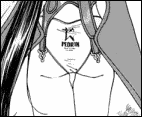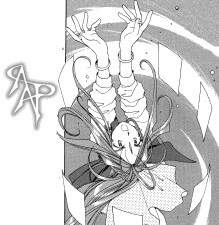Many parts of Oh! My Goddess are loosely based off of Norse mythology. For those of you who don't know, that's the original religious belief system of the region around Norway. Oh! My Goddess seems to be a mix of Norse mythology, Japanese spiritualism, and Fujishima's own original conception. The following information is from what little I know about Norse mythology, but keep in mind that some of this is debatable, since historians themselves are unsure about much of it.
In the Beginning
The beginning of the universe is hard to explain in Norse mythology, not to mention long. The main point is before anything else existed (even before time itself), there existed three things: Niflheim, the land of ice and mist, Muspellsheim, a sea of raging flames, and Ginnungagap the bottomless void. The world was created, and different realms were set aside for various races of beings. In the center of it all is Yggdrasil, the world tree.
Yggrasil was planted by the gods in the center of Midgard (the human realm), and its roots reached through two other realms as well, Jotunheim (realm of the Jotuns), and the third in Niflheim. Some say that below Yggdrasil lay Helheim - the land of the dead, others say Helhiem lies somewhere in Niflheim. High within Yggdrasil lay the realm of the gods Aesgard, as well as Alfheim the realm of light elves. As long as Yggdrasil continues to grow, the world will continue to exist.
At the base of Yggdrasil there are three wells: The Well of Wisdom called Mimisbrunnr, guarded by Mimir; The Well of Fate called Urdarbrunnr, guarded by the Norns; and the Hvergelmir called the Roaring Kettle, which is the source of many rivers. There are three Norns, also known as the goddesses of destiny. Their names are Urd, Verdande and Skuld. The Norns are quite different from the OMG goddesses. In Norse mythology, the Norns are almost evil. A few traits could be loosely taken as the OMG goddess characteristics. Urd is the goddess of fate - in OMG she likes to play mach-maker. Verdande is the most sympathetic of the goddesses in Norse mythology, and Skuld has little patience for human affairs. Another interesting note about the Norns is that they tended the world tree Yggdrasil by trying to prevent the decay of its roots, much like the OMG goddesses tend the computer Yggdrasil, keeping everything running smoothly.
Norse Mythology particularly differs from other beliefs when concerning the end of the world. Norse Mythology goes into such detail, that it's as if it's already happened. In "Terrible Master Urd" some parallels are seen with this view. The main point of interest is that the Lord of Terror releases the wolf known as Fenrir, although it is defeated by Belldandy. In Norse mythology, Fenrir was a wolf cub who was taken in by the gods, but grew so large that the gods began to fear the it. They manged to trick Fenrir into being chained, however the chains won't hold forever. It is said when the end of the world takes place, the wolf Fenrir will finally break free. Fenrir will wreak destruction upon the world and will slay Odin himself.
The Vanir bird: In Oh! My Goddess, the Vanir bird can cull past experiences from a person who has long forgotten them. Vanir are actually one of the two classes of gods in Norse mythology. The Aesir are the gods of sky, the Vanir are the gods of earth (also associated with the sea). They represent riches and fertility. As far as I know the bird doesn't have anything to do with Norse mythology itself, it just seems to be a term that Fujishima chose.
Another story tells of Urd taking the horse known as Sleipnir from the palace of the almighty in order to help heal Belldandy. Sleipnir is an eight legged horse which is the steed of Odin in Norse mythology.
P e o r t h ' s N a m e
Also of semi-relevant interest is the origin of Peorth's name. Peorth was named after a rune which is a character used by the Norse people. A rune functions as a letter of the alphabet, but also stands for a word which the rune itself means. Peorth is named after the rune Perth. Some scholars believe Perth means fruit, but generally scholars are unsure of its meaning. The Rune Perth is also a part of Peorth's wardrobe, and is ever so eloquently written on her butt.

In her next big appearance (Mystery Child) there is a difference. If you look at Peorth's butt (and why wouldn't you be?) you'll notice that her outfit is black in the back and there isn't any visible writing. Maybe Fujishima thought it wasn't worth the effort?


